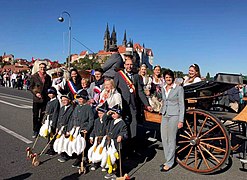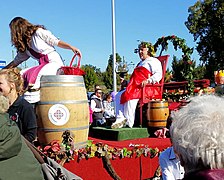Meissen Wine Festival
The Meissen Wine Festival is an annual folk festival and at the same time the largest festival in the Saxon city of Meißen . The organizer is the Meißner Gewerbeverein, which organizes the festival on behalf of the city of Meißen. The region's winemakers will also present the latest wines to the public. The festivities usually take place over three days on a September weekend. They start on Friday evening and end on Sunday evening with a fireworks display on the Elbe . In 2020 the wine festival will take place from September 25th to September 27th in a slightly different form. In order to avoid large crowds, the celebrations will be spread across the entire city.
history
Historical origin
Today's wine festival has probably found its historical origin through the cultivation of wine in this region of Saxony . Accordingly, wine has been grown near Meissen since 1161. When the grape harvest was brought in, there were festivals for the winemakers even then, which were still celebrated together with the harvest festival.
Religious origin
The religious origin of the festival can be seen on the one hand in the Christian celebration - as a festival in autumn when the believers thank God for the gifts of the harvest during the harvest festival. On the other hand, the festival has a close relationship with the many legendary reports about the life of Bishop Benno von Meißen , whereby the wine is usually of great importance. Benno is the patron saint of Munich and today's diocese of Dresden-Meißen .
Development since 1929
The festival had many names until it was finally referred to as the wine festival . A traditional “ cider festival” was held especially in the 1930s . During this time, and even later, it was not uncommon for the program brochures issued specifically for the festival to be misused for political propaganda. Until 1949, the wine festival , which has always been popularly called itself, was officially celebrated as the “district harvest festival ”. Names like " Harvest Festival " or " Traditional Wine and Harvest Festival " followed again . From 1953 the name Weinfest was used again . The date varied between August and the end of September. There were also differences as to whether the individual events were free of charge or had to be paid for with a low fee. For this purpose, medals made of porcelain stoneware or biscuit porcelain, which were made in the porcelain factory in Meissen with different motifs, were sold as admission tickets for years . But in a few years there were festival badges made of other materials. They were made of leather or metal. There were even artificial flower motifs with printed bows. Those who wore such a medal, plaque or badge usually had free entry to the public festival areas and events.
Wine from the region was not always offered there. In the GDR , wines from Meißen were a sought-after export item and you therefore mostly had to fall back on imports from socialist countries . The traditionally offered table grapes were also imported and sold in large and sufficient quantities. There were always large events in the castle courtyard of the Albrechtsburg for the wine festival, at which well-known artists performed. Other cultural events on open-air stages in the city area were also part of the wine festival. There were also numerous showmen and rides. A highlight at that time was the so-called " castle lighting ". The Albrechtsburg and the cathedral were impressively illuminated with colored lights. The festival is still celebrated today with several, often changing, main attractions. The Sunday wine festival parade has remained an integral part of this, and it moves through the entire city with many festively decorated floats. The tradition with the final fireworks has also been preserved. A personal visit by the Saxon Wine Queen to the Meißen wine festival was mandatory until 1997. Since 1998, the “ wine sovereigns ”, which is now a wine queen and two princesses, have been attending the festival regularly. The " wine sovereignty " is elected for one year by the winegrowing association of Saxony as part of a special election event.
Medals
Medals made of porcelain stoneware or white bisque porcelain as entry tickets to the Meissen Wine Festival were first issued in 1933 and later designed by various artists from the Meissen porcelain factory. They are still collected today by special collectors and have been individually described and cataloged in specialist medals literature. They all carry the crossed course swords as a symbol of the manufacture; occasionally colored decors appear on the pieces.
Others
- Visitor numbers: In 2008, up to 60,000 visitors came to the Meissen Wine Festival. In 2016 there were around 50,000 visitors and around 45,000 visitors to the 2017 Wine Festival.
literature
- Helmuth Gröger: A thousand years of Meissen. Meissen 1929.
- Karl Scheuch: Medals made of porcelain. Volume IV, Verlag B. Strothotte, Gütersloh, 1970.
- Günter Naumann: Meißner Chronik 1989–1996. Kreissparkasse Meißen, Meißen, 1996, pp. 109, 139, 175 and 217.
- Günter Naumann: City Lexicon Meißen. Sax – Verlag, Beucha, 2009, pp. 360 to 361.
- Gerhard Steinecke: Our Meißen - 1929-2004. Meißner Tageblatt Verlags GmbH, 2004, pp. 223, 225 and 309.
Web links
Homepage "Weinfest Meißen" from the trade association Meißen e. V. Accessed August 4, 2020.
Individual evidence
- ^ City of Meißen, festivals and celebrations, Meißner Weinfest Website of the city of Meißen. Retrieved August 4, 2020 .
- ↑ Gewerbeverein Meißen e. V.
- ↑ Liselotte Closer: A Brief History of the City of Radebeul. In: Dresdner Hefte No. 54, Kulturlandschaft Lößnitz-Radebeul. Dresden 1998.
- ^ Karl Scheuch: Medals made of porcelain. Volume IV.
- ↑ sz-online from July 22nd, 2009, September 27th, 2016 and October 7th, 2017.






